Main content
Top content
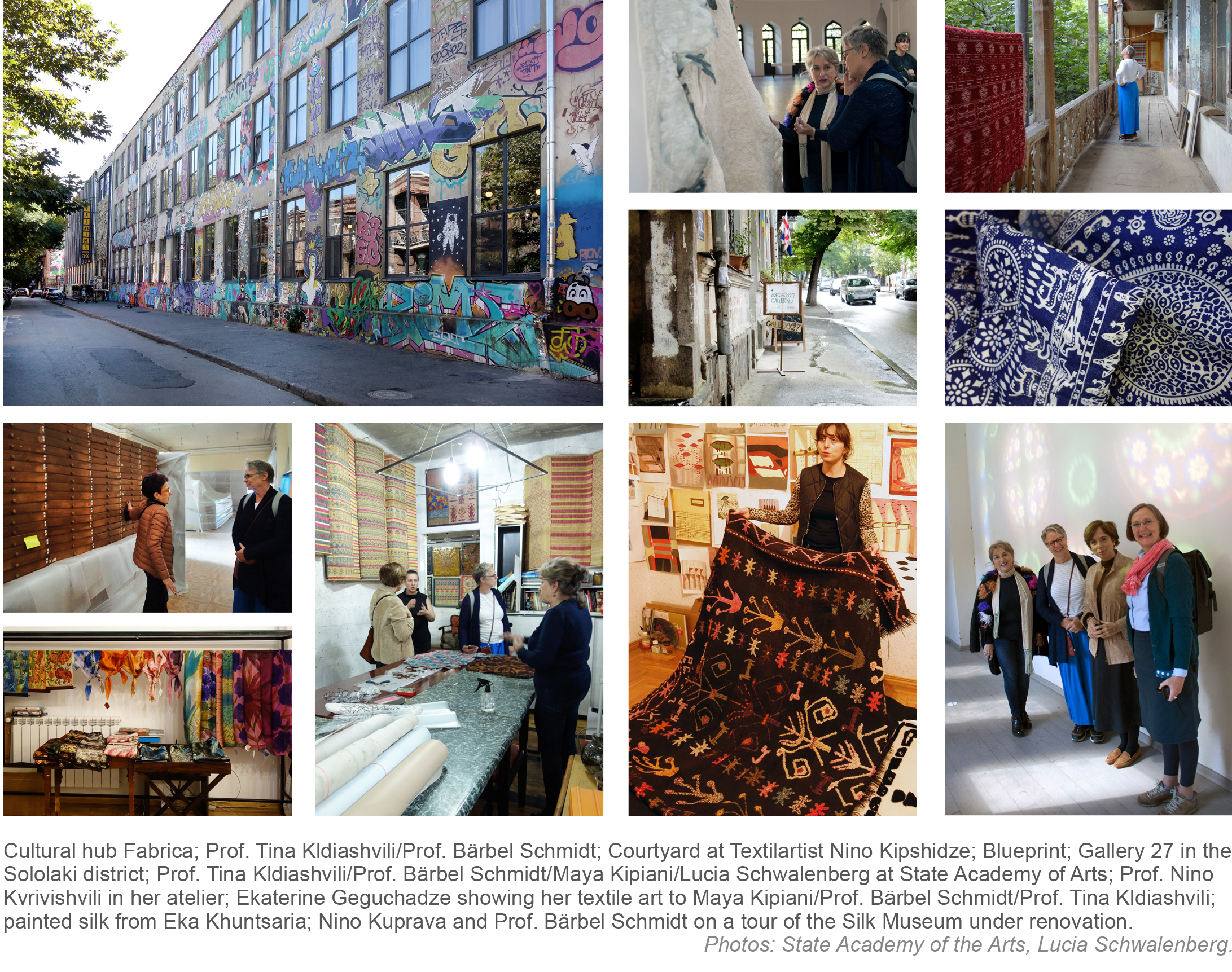
Georgia cooperation travel
Textile culture at the crossroads between West and East
Textile culture, the cultural heritage blue print and the crossroads between East and West were the main topics for a cooperation trip to Georgia by Prof.in Bärbel Schmidt and her research assistant Lucia Schwalenberg. Countries like Georgia at the interface between Europe and Asia are characterized by a multi-layered approach in relation to cultural history, contemporary design and the challenges of the Post Soviet Age. Georgia strives to revive manual and industrial skills and techniques. Universities and cultural institutions research and activate textile techniques such as blue printing, felting, weaving and silk processing. These techniques are taught at the State Art Academy in Tbilisi and supported by a growing number of textile artists and institutions such as the UNESCO. The cooperation travel was funded by the German Academic Exchange Service/DAAD to prepare for mobility projects with partner countries. In order to continue the project, concrete cooperation options will be explored with the State Academy of Arts, its experimental research laboratory for Blauprint/Lurja Supra, the State Silk Museum and regional textile artists and other possible institutions. --> Read more in the illustrated travel report :-)
Further informations: Prof. Dr. Bärbel Schmidt, 0049 (0)541 969-4217, baerbel.schmidt@uni-osnabrueck.de
Photos: State Academy of the Arts, Lucia Schwalenberg.
-------
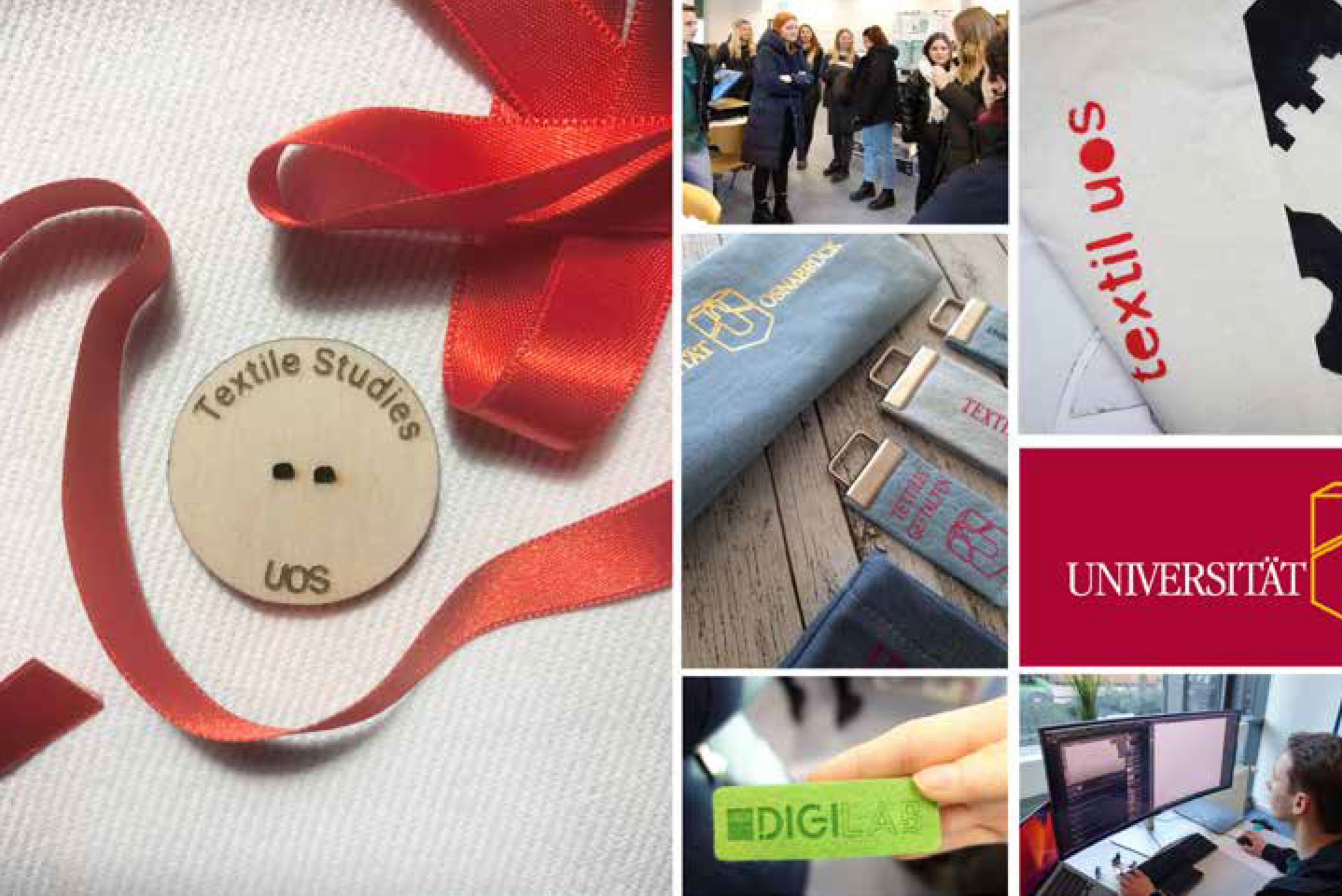
souvenirs - gifts for guests and friends
Textile students develop prototypes
souvenirs are something I bring back or get brought back from a trip. Takeaways convey memories and create appreciation. On excursions, cooperation events or visits by foreign and domestic guests, souvenirs are presented in the form of host gifts. For example, on a textile design excursion to Sri Lanka or a cooperation trip to Finland. The question arises: What is appropriate, adequate ... and handy? Textile students have thought about this. Prototypes such as a measuring tape made of vegan pineapple leather, bags printed on Osnabrück manhole covers or a digitally embroidered travel wrap were created, as well as a friendship bracelet knotted in an archaic knotting technique or a peace dove made in a Japanese crochet technique.
For supporting the students with the prototypes, special thanks go to Timos Zdoupas and Sonia Tavani at the DigiLab of the University of Osnabrück, to Lena Luttmer at the Unishop, to Anke Schmitter, Anita Tiedtke, Martina Witte, Sandya Biewer and Jutta Schulke, in the StichLab to Anke Beccard and in the Open Workshop of Textile Design to Alex Büsing and Anja Leshoff, as well as for inspiring visits to the Museum of Cultural History, the Tourist Information of the City of Osnabrück and the Leysieffer chocolate factory.
Thanks to the commitment of the students: Lea Blanken, Anja Breckweg, Eylül Dogan, Eva Eggert, Lissy Felgenhauer, Carlotta Gödeker, Marco Hurrelbrink, Daria Ivanov, Melanie König, Jessica Lange, Janis Lüken, Pia Mennewisch, Marieke Oevermann, Marlene Prieshoff, Kyra Steffen, Julia Thiessen, Jana Vorpahl. As well as in the preparation workshop: Catherine Hildebrandt, Celine Krumland, Ina Kumar, Melina Marquardsen, Kathrin Meese, Ariana Memmen, Rebecca Röhrs, Kevin Schmidt and Amelie Wulff.
Text und Photos: Lucia Schwalenberg und Anja Leshoff
-------
Cooperation Travel
Textile Studies, Craft Education and Makerspaces
From Osnabrück to Berlin
Textile Studies, Craft Education and Makerspaces were the main topics of a cooperation tour from Osnabrück via Hannover, Hildesheim, Halle and Wildau to Berlin. The trip was part of funded project "Craft Education and Makerspaces" with travels to Finland, The Netherlands and Belgium (see below). The project is supported by the Lower Saxony Ministry for Science and Culture through the program INTENSIVinternational which aims to strenghthen pan-European colaborative projects.
The goal of the Textile Studies program at Osnabrück University is to train future textile teachers. Textile Studies has a special responsibility to promote Education for Sustainable Development and creative skills. The focus on the research is on Makerspaces as future-oriented locations for a shared economy, shared education and equipment and as places for joint knowledge transfer.
Travelreport: Osnabrück to Berlin
Picture text: Idea Space - Area at Hafven/Makerspace Hannover.
Further informations:
Prof. Dr. Bärbel Schmidt, 0541 969-4217, baerbel.schmidt@uni-osnabrueck.de
Dipl. Des. Lucia Schwalenberg, 0541 969-4219/05103 706423, lucia.schwalenberg@uni-osnabrueck.de
Fotos: Prof. Dr. Bärbel Schmidt/Dipl. Des. Lucia Schwalenberg
-------
Netherlands and Belgium Cooperation Travel
Textile Studies, Craft Education and Makerspaces
Funded by the Lower Saxony Minstry for Science and Culture
Textile Studies, Craft Education and Makerspaces was the focus of a coopertion travel from Textiles Studies Department to Netherlands and Belgium. The travel was funded by the Lower Saxony Ministry for Science and Culture, through the support program INTENSIVinternational that aims at strengthening the cooperation between European countries.
The goal of the Textile Studies program at Osnabrück University is to train future textile teachers, stimulate the students' curiosity and excitement for textiles, and encourage further studies of textile culture. The Textile Studies department offers a setting where the students experience that knowledge is unlimited and learnig is for life.
A report about the travel: Netherlands/Belgium Travelreport
Picture text: Impressions from Netherlands and Belgium: TextielMuseum Tilburg/outside view; Textile Research Centre, Leiden/Gillian Vogelsang-Eastwood/Bärbel Schmidt; Texlab Liège/design station; Fashion for Good/Hul de Kes; Waag TextileLab/Michelle Vossen/Maro Pebo/Bärbel Schmidt; Waag TextileLab/guild auditorium; Waag TextileLab/Amsterdam; TextielLab Tilburg/jacquard weaving lab.
Further informationen:
Prof. Dr. Bärbel Schmidt, 0541 969-4217, baerbel.schmidt@uni-osnabrueck.de
Dipl. Des. Lucia Schwalenberg, 0541 969-4219/05103 706423, lucia.schwalenberg@uni-osnabrueck.de
Fotos: Prof. Dr. Bärbel Schmidt/Dipl. Des. Lucia Schwalenberg
-------
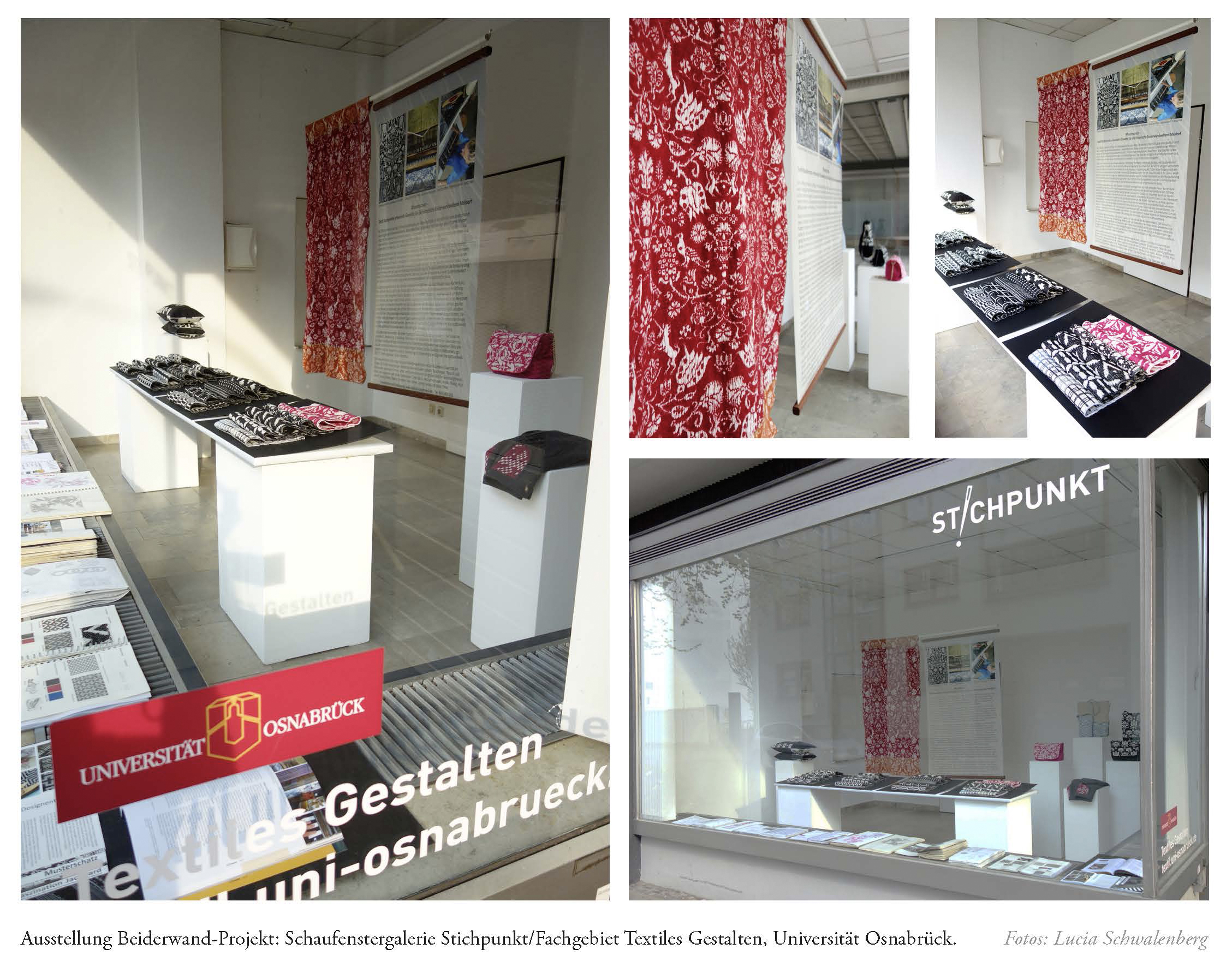
-------
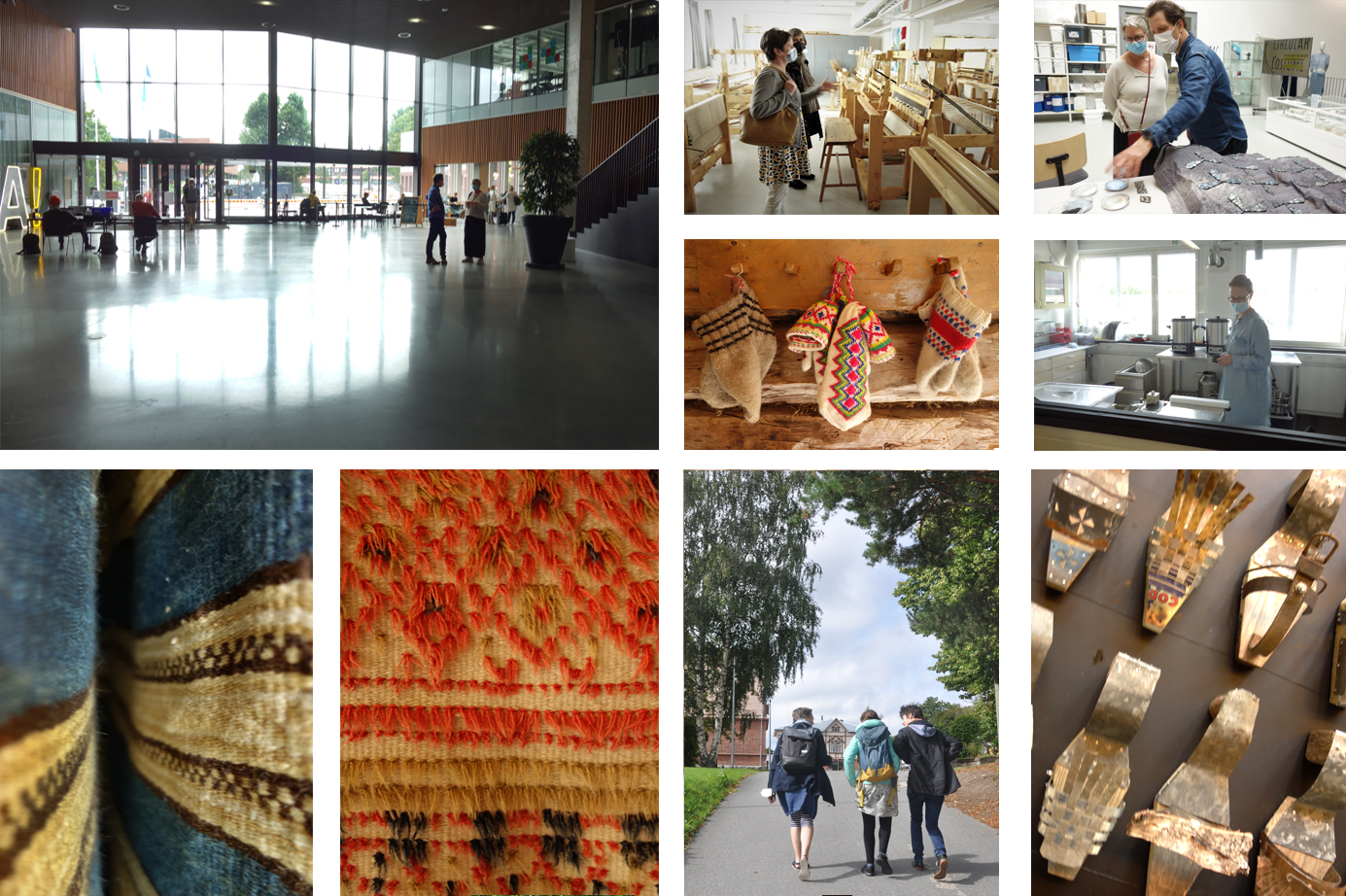
Finland Cooperation Travel
Textile Studies, Craft Education and Makerspaces
Funded by the Lower Saxony Minstry for Science and Culture
Textile Studies, Craft Education and Makerspaces was the focus of a coopertion travel from Textiles Studies Department to universities and institutions in Finland. The travel was funded by the Lower Saxony Ministry for Science and Culture, through the support program INTENSIVinternationa that aims at strengthening the cooperation between European countries in the full amount of Euro 10.000. The project will nun be proceeded by concreting the cooperation and exploring cooperation option between Finnish Universities, Osnabrück University as Lower Saxony University and the Textile Research Centre in Leiden/Netherlands.
The goal of the Textile Studies program at Osnabrück University is to train future textile teachers, stimulate the students' curiosity and excitement for textiles, and encourage further studies of textile culture. The Textile Studies department offers a setting where the students experience that knowledge is unlimited and learnig is for life.
Nordic countries like Finland are pursuing a holistic approach to Craft Education. They treasure lifelong learning, which is cross-generational, corss-cultural and interdisciplinary. In addition to finding this learning methodology in the different schools and universities across Finland, it is also embedded in the Craft Organisation Taito and several pop-up Makerspaces. International contact partners in Universities in Finland are Rovaniemi, Turku/Rauma und Helsinki/Eespo.
A report about the travel at Digital Weaving Norway: Finland Travel Diaries: Textile Studies, Craft Education and Makerspaces
Picture text: Aalto University/Entrance hall; University Helsinki: Weaving Workshop with Prof. Pirita Seitamaa-Hakkarainen and Prof. Sirpa Kokko; Urs Dierker explaining his circular costume design to Prof. Bärbel Schmidt; Gloves/Local Heritage Museum Rovaniemi; Makerspace Völtila/Pirita Lauri with Digitaljacquard TC2; handwoven woolen Ranuus/Local Heritage Museum Rovaniemi; University Turku/Rauma Campus/Craft Teacher Education; Jätermateraalikengät/Ana Nuutinen/Art Exhibition by staff from University of Lapland/Arktikum Rovaniemi.
Further informations:
Prof. Dr. Bärbel Schmidt, 0541 969-4217, baerbel.schmidt@uni-osnabrueck.de
Dipl. Des. Lucia Schwalenberg, 0541 969-4219/05103 706423, lucia.schwalenberg@uni-osnabrueck.de
Fotos: Prof. Dr. Bärbel Schmidt/Dipl. Des. Lucia Schwalenberg
-------

Heritage of patterns
Textiles students develop woven patterns for the historic Beiderwand Weaving Workshop Meldorf
The Stiftung Mensch foundation operates a Beiderwand weaving workshop, unique throughout Germany, in the historic Altes Pastorat building complex in Meldorf.
The weaving workshop also includes a historically evolved heritage of patterns with complex Jacquard punchcards, historic looms, machinery and equipment, as well as an archive of drawings and patterns. The workshop is operated by Stiftung Mensch, with the participation of disabled employees. Production is in keeping with historic originals.
Thanks to contact with workshop leader Wolfgang Sternberg, the idea was born to develop new, timeless designs for the historic museum weaving workshop in collaboration with students. Students had already developed designs in previous semesters, e.g. for a Bauhaus exhibition at the Tuchmacher Museum in Bramsche, for Osnabrück University’s academic scarf, and for a social project in Sri Lanka.
Wolfgang Sternberg had helped to restore the department’s own punchcard Jacquard loom during the restructuring of the Textile Studies workshop. Now the opportunity arose for further collaboration – a cultural-historical approach to Beiderwand weaving on a contemporary basis.
The following students were involved in the project: Canan Barcin, Jessica Kirschmann, Annika Klinkig, Anja Leshoff, Rieke Ohlsen, Sophia Schlimm, Heidrun Schneider, Zeynep Yaman and Beyza Yilmaz. The seminar was led by Lucia Schwalenberg, textile designer and research assistant at the Department of Textile Studies.
Report of the European Textile Network ETN
More Information: Universität Osnabrück/Fachgebiet Textiles Gestalten, Dipl. Journ./Dipl. Des. Lucia Schwalenberg: +49541-969-4219 / +495103-706424, lucia.schwalenberg@uni-osnabrueck.de
Photos/text: Lucia Schwalenberg
------
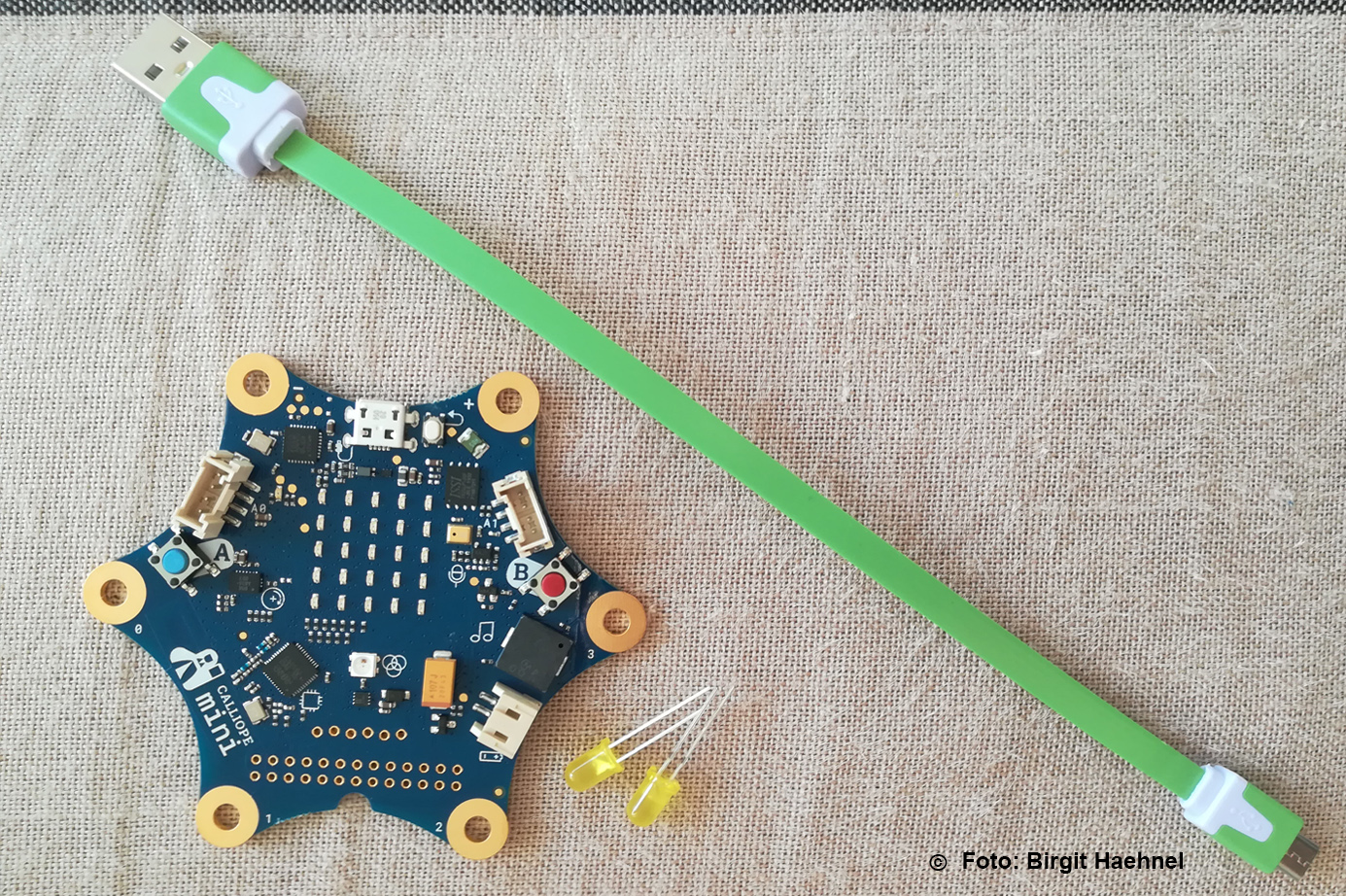
Digitization with needle and thread
Allocation of funding under Osnabrück University´s "LehrZeit III" strategy package
All areas of life – and especially textiles – are undergoing a digital transformation. Tomorrow’s teachers must therefore address this issue and integrate it into their teaching more and more as time goes by.
The Digitization with needle and thread research project translates the current discussions on the digitization of society (Industry 4.0) to textile studies. The aim is to creatively integrate digital or electronic media into textile practice, encouraging students to experiment, discover and design using a combination of analogue and digital media.
Learning plans and curricula are designed that bring together advanced education science, specialist knowledge of teaching theory, and school-based methods and approaches. The focus is on textile techniques that are transferred to digital and electronic design methods, taking into account aesthetic aspects.
Examples include sewing textile conductors, weaving or embroidering electrical contacts, programming miniboards (Calliope Mini), creating digital weaving patterns, and connecting these e-textiles to smartphones and tablets. Special emphasis is placed on expanding physical computing platforms and creating stable connections, as well as on the conscious and therefore sustainable use of resources.
Video LehrZeit Digitization with needle and thread
Contact
Prof. Dr. Birgit Haehnel, birgit.haehnel@uni-osnabrueck.de
Lena Küppers, research assistant, lena.kueppers@uni-osnabrueck.de
-------
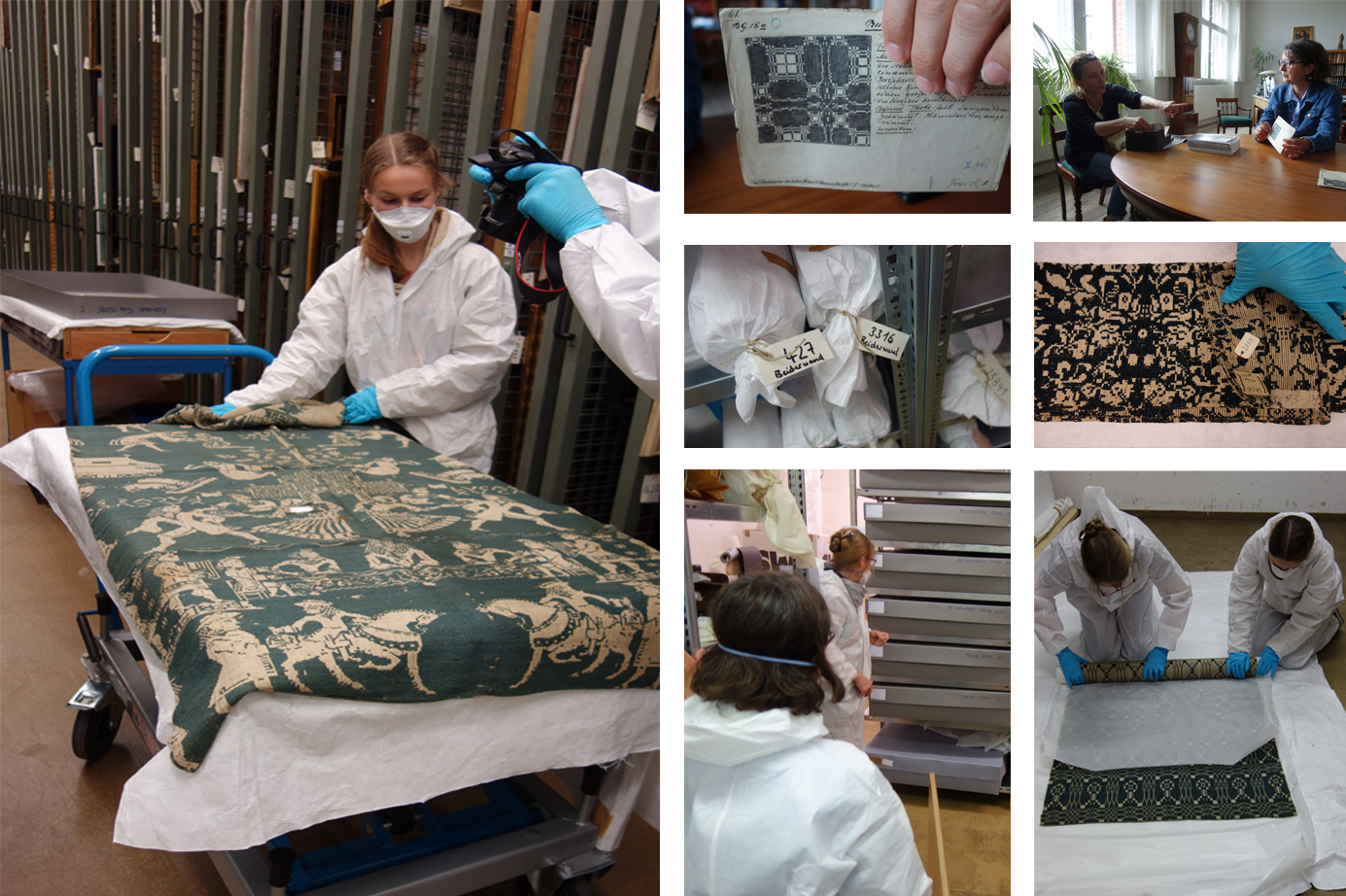
Beiderwand Archives at Museumsberg Flensburg
Research for dissertation project
Our research assistant Lucia Schwalenberg is currently researching her dissertation on the topic of historic Beiderwand weaving in Schleswig-Holstein. A visit to the stacks of Flensburg’s Museumsberg proved to be a rich source of material. In his capacity as director of the museum, Heinrich Sauermann had amassed an extensive collection of historic Schleswig Beiderwand weaving at the end of the 19th century.
Under the direction of museum master Petra Heide-Petersen and assisted by Martha Andersen, who is doing a cultural Voluntary Social Year, Schwalenberg was given the opportunity to examine the collections at the depot. Owing to the sublimation of the textile collections with lead and toxins decades ago to prevent damage by pests, protective suits and masks must always be worn when working in the archives..
Text und photos: Lucia Schwalenberg
-------
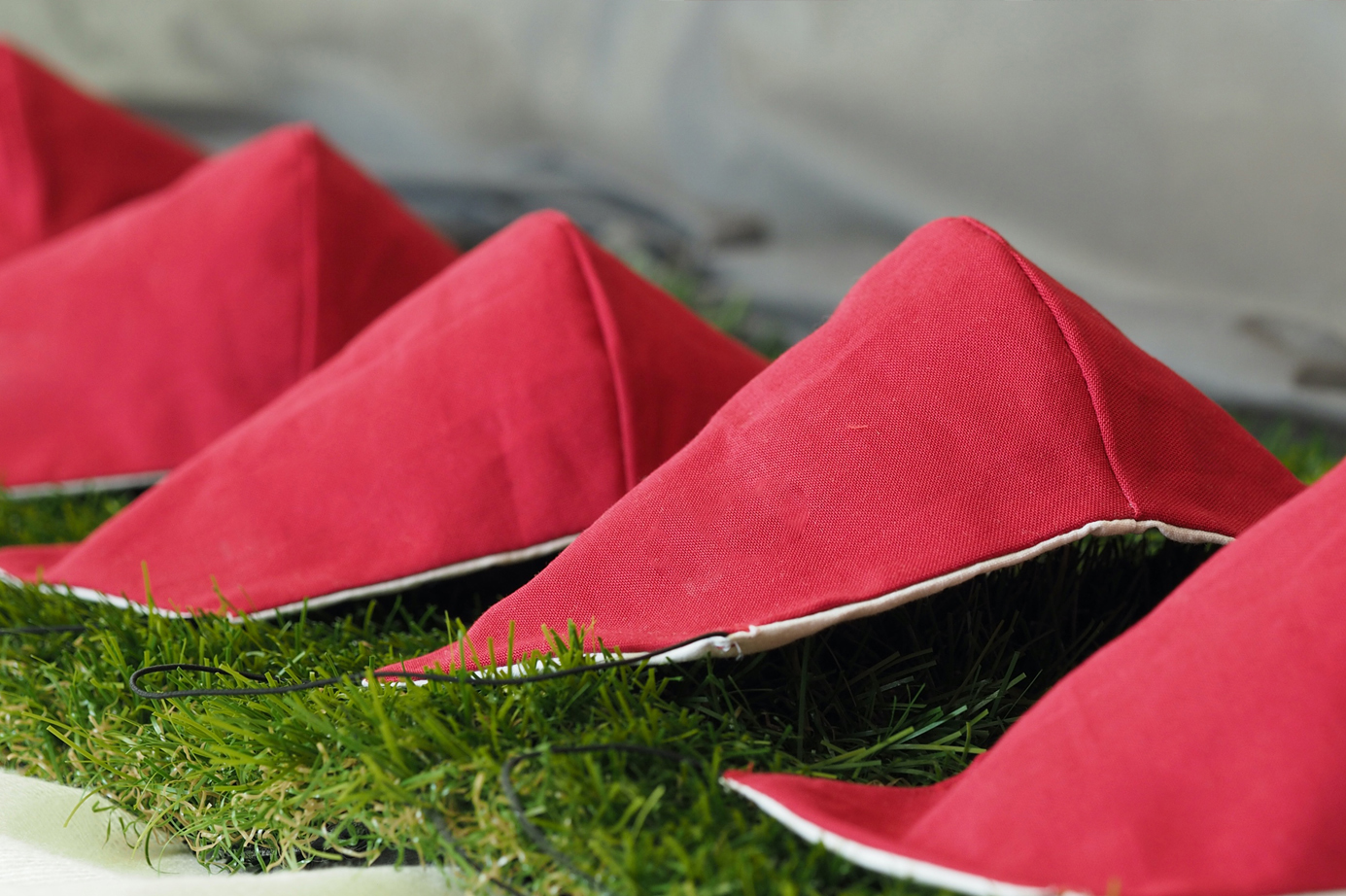
Foto: Wolfgang Sparenberg
Ministry for Science and Culture approves funding for textile research project
Approval for research project at the Textile Research Centre Leiden for Textile Studies
The application submitted by Professor Dr. Bärbel Schmidt to the Ministry for Science and Culture of Lower Saxony on the topic of “Narrative material – research-based notes on the vestimentary memory of the collection of German clothing at the Textiles Research Centre in Leiden” has been approved. The department has been awarded €6,800 for the implementation of the project, which focuses on garments of German provenance held at the Textile Research Centre in Leiden.
The TCR is a stand-alone research institute that specializes in anthropological and archaeological topics in the field of textiles and clothing. The independent research institute has a collection of around 25,000 textile items from all periods and from all over the world, including Germany. The staff based at the research institute primarily explore the question of what people wear to express their identity. They also deal with the set of issues concerning pre-industrial textile technology (see www.trc-leiden.nl/).
Despite intensive efforts, not all garments and textiles have been systematically recorded and scientifically processed yet, owing to a lack of staff. This is also the case for the items of German origin in the collection. An unfortunate desideratum, given that clothing very often serves to convey personal and emotionally charged meanings, expressing life history. A review of the garments could lead to a better understanding of potentially different styles of dress in the Netherlands and Germany. It could also shed light on techniques of the body or body-related experiences through clothing in these two countries, as well as clarify the questions of which regionally specific garments were included in the Textile Research Centre, and why. The garments could also be used to analyze everyday clothing behavior in the two countries.
The first step will involve students taking an inventory of garments and textiles using Jumloo additions, an inventory program tailored to the Textile Centre. The second step is to determine what exactly the items were used for, their material value, material structure, ornamentation, the protection or social prestige they offered, as well as subjective feelings, interpretations and memories, and the interactions and narratives that find expression in them, if provenance can be determined (see Hartmann/Holecek 2011, p. 187f.).
Text, Photosand more information: Prof. Dr. Bärbel Schmidt.
------------
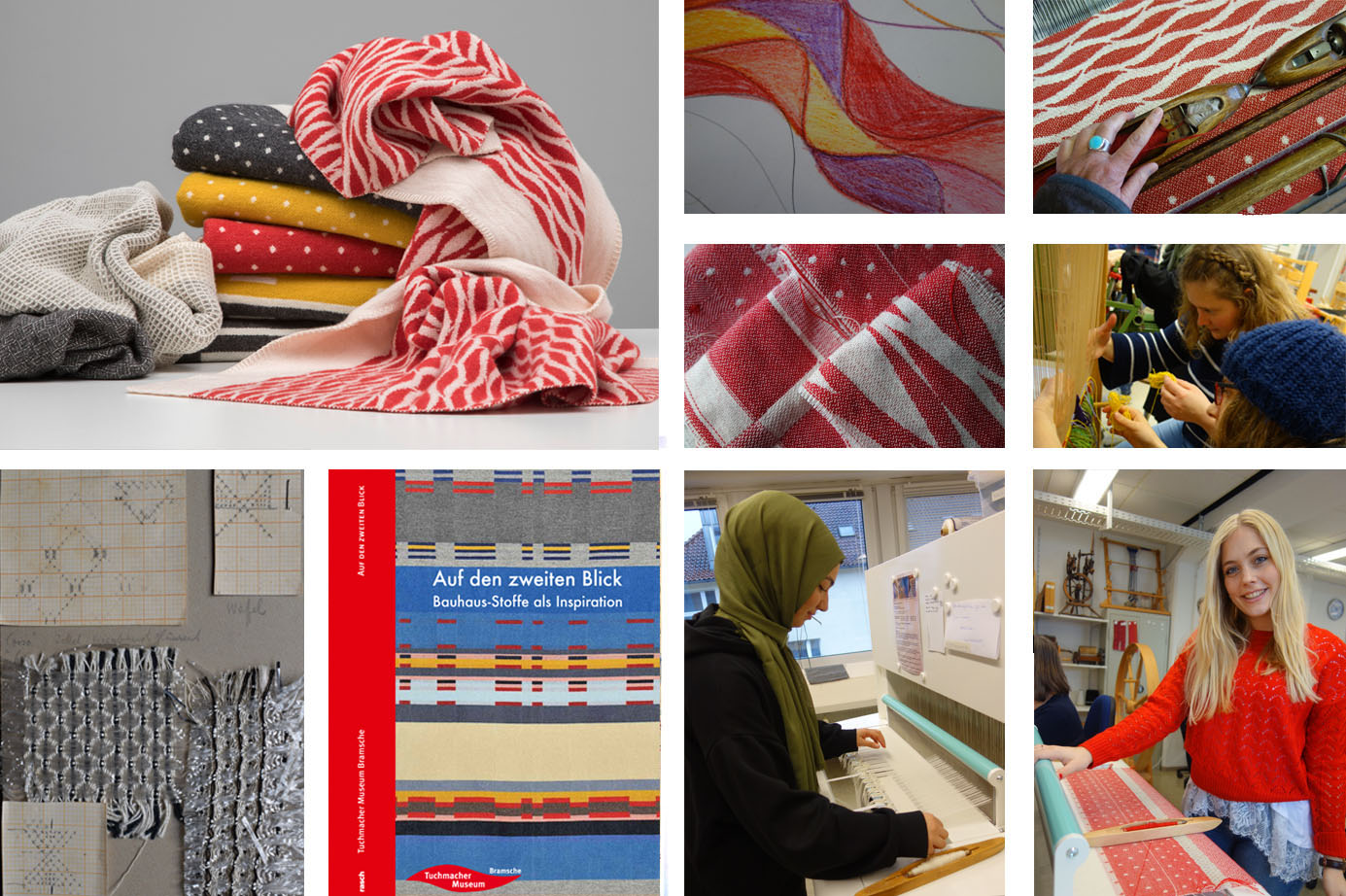
At Second Glance – Bauhaus Fabrics as Inspiration
Cooperation between the Tuchmacher Museum Bramsche and Osnabrück University / Textile Studies
Kerstin Schumann, Museum Director at the Tuchmacher Museum Bramsche, and Annette Hülsenbeck and Lucia Schwalenberg from Osnabrück University select archive samples by Gunta Stölzl, master weaver at the Bauhaus, for the exhibition entitled “At Second Glance – Bauhaus Fabrics as Inspiration”. To mark the 100th anniversary of the Bauhaus in 2019, Textile Studies teamed up with the museum to pay tribute to the Bauhaus weaver with this special exhibition based on Gunta Stölzl’s archive of patterns.
Taking these samples as a starting point, students involved in the “Bauhaus Weaving Workshop Project” gain inspiration, recreate and reinterpret the samples, and adapt them to the technical conditions of the museum’s Jacquard loom. This exhibition marks the first time that the museum has woven its own patterns to complement the existing three historic punchcards. The wool fabrics developed from the Stölzl samples will be available exclusively from the museum shop as a collection for the opening of the exhibition.
A new experience for visitors, who will be able to trace the path from the source of inspiration, the design, card punching and weaving to the finished product in a single illustrative unit. Most of the wool yarns for the production of the collection were produced using the museum’s own machinery, such as the carding machine and the selfactor.
Photos: Ralf Orlowski (top left), Lucia Schwalenberg.
text: Kerstin Schumann/Lucia Schwalenberg
Hülsenbeck, Annette/Schumann, Kerstin/Schwalenberg, Lucia/Thörner, Ilka
Auf den zweiten Blick. Bauhaus-Stoffe als Inspiration
80 Seiten, zahlreiche farbige Abbildungen
Format 14,8 x 21 cm
Bramsche 2019
ISBN 978-3-89946-302-6
------------
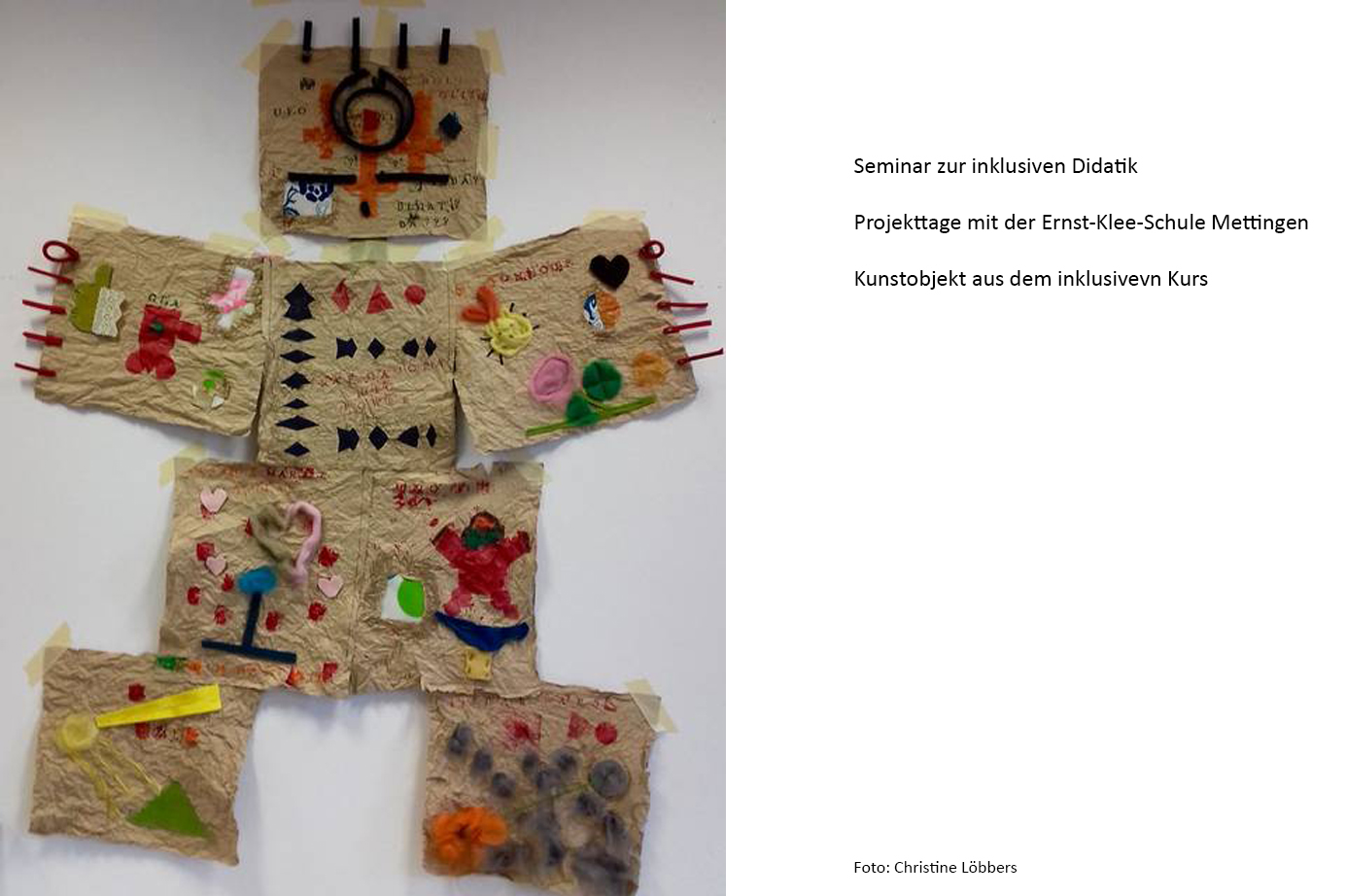
“Inclusive Education” project days
Collaborative project with Ernst Klee School in Mettingen
Around 1,000 children created almost 800 pieces for the 2019 “Jugend gestaltet” competition run by the District of Steinfurt. A total of 140 pictures and 53 objects were selected for exhibition from all entries by a jury of experts. Among the selected participants were four classes from the Ernst Klee School in Mettingen (Landschaftsverband Westfalen-Lippe special school), which cooperated with students training to become textile studies teachers in winter semester 2018/19.
During a seminar on “Inclusive Education”, the students spent two project days addressing the topic of heterogeneity and cultural diversity with pupils from the Ernst Klee School using various textile techniques under the direction of research assistant Christine Löbbers. Another class focused on critically examining plastic waste in the world’s oceans, implementing the theme with the use of textiles and creative techniques. The aim of the seminar was to give students an insight into classroom situations with children who have special educational needs.
The seminar was funded and supported by Osnabrück University’s EKBI (“Expertise and Cooperation for a Basic Qualification in Inclusion”) project. In the context of tandem teaching, the course was held in cooperation with didacticians and external (special education) experts.
------------
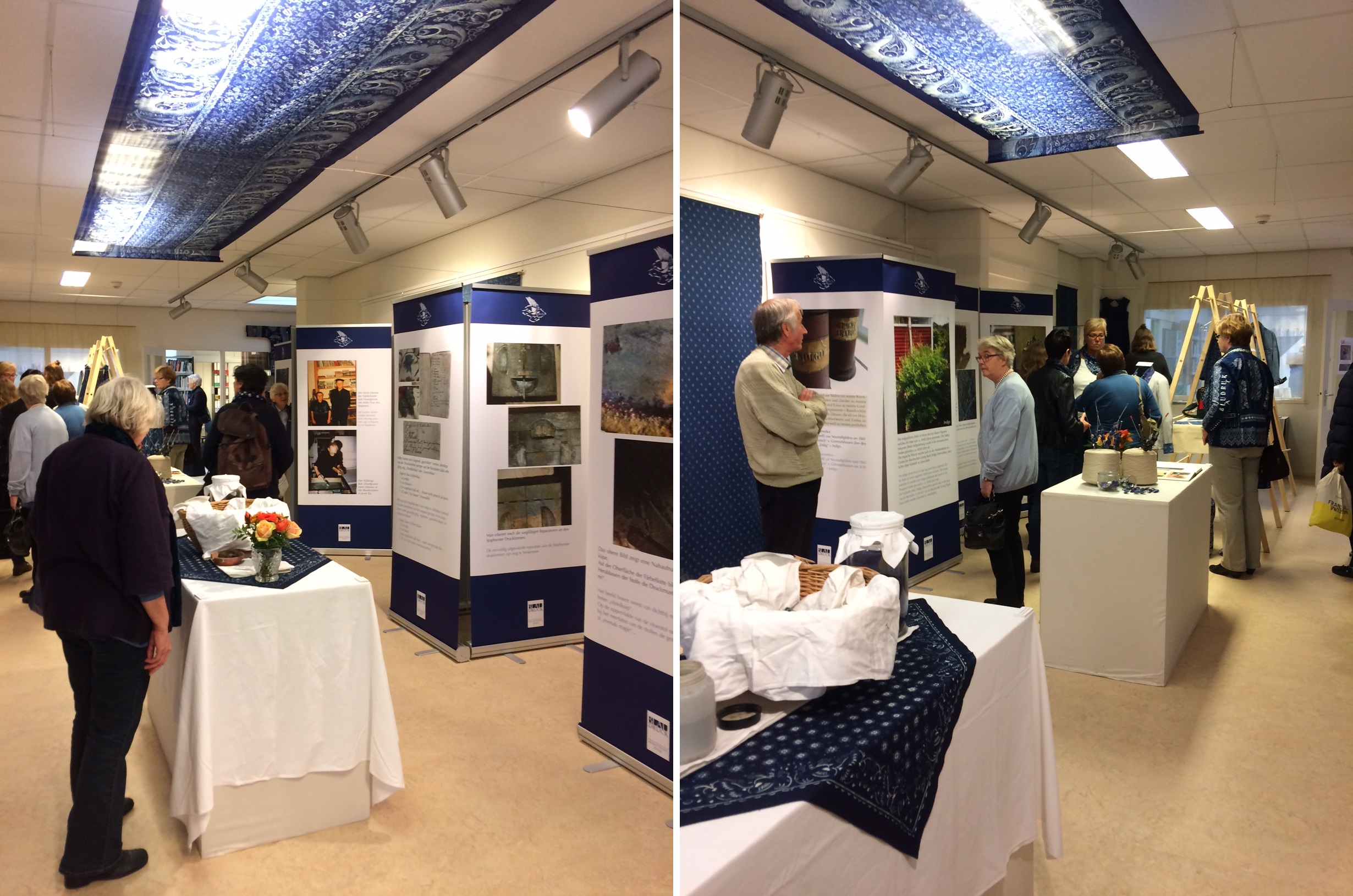
Traditional textile crafts moving into the modern age
Exhibition on indigo blue-dyeing and stipwerk at the Textile Research Centre, Leiden, the Netherlands
It is thanks to the commitment of indigo dyer Georg Stark that the textile craft of indigo blue-dyeing was included in the Nationwide Inventory of Intangible Cultural Heritage for Germany.
In winter semester 2018/19, textile students explored these historic craft techniques during a seminar on “World Cultural Heritage: Indigo Blue-Dyeing and Stipwerk”. One key aspect is the question of how these techniques can become part of our awareness again, and which products are conducive to putting these two techniques back in our everyday lives.
This led to the creation of lots of modern clothes and objects made of fabrics featuring old indigo dyeing patterns. All exhibits prompt visitors to grasp, feel, touch or change them.
Participating Students: Julia Falke, Gesche Hillmann, Marie-Theres Kempermann, Ann-Kathrin Leimkuhle, Caroline Polaczyk, Naina Reuter, Julia Schalle.
Participating lecturers: Prof. Dr. Bärbel Schmidt, Christine Löbbers
------------
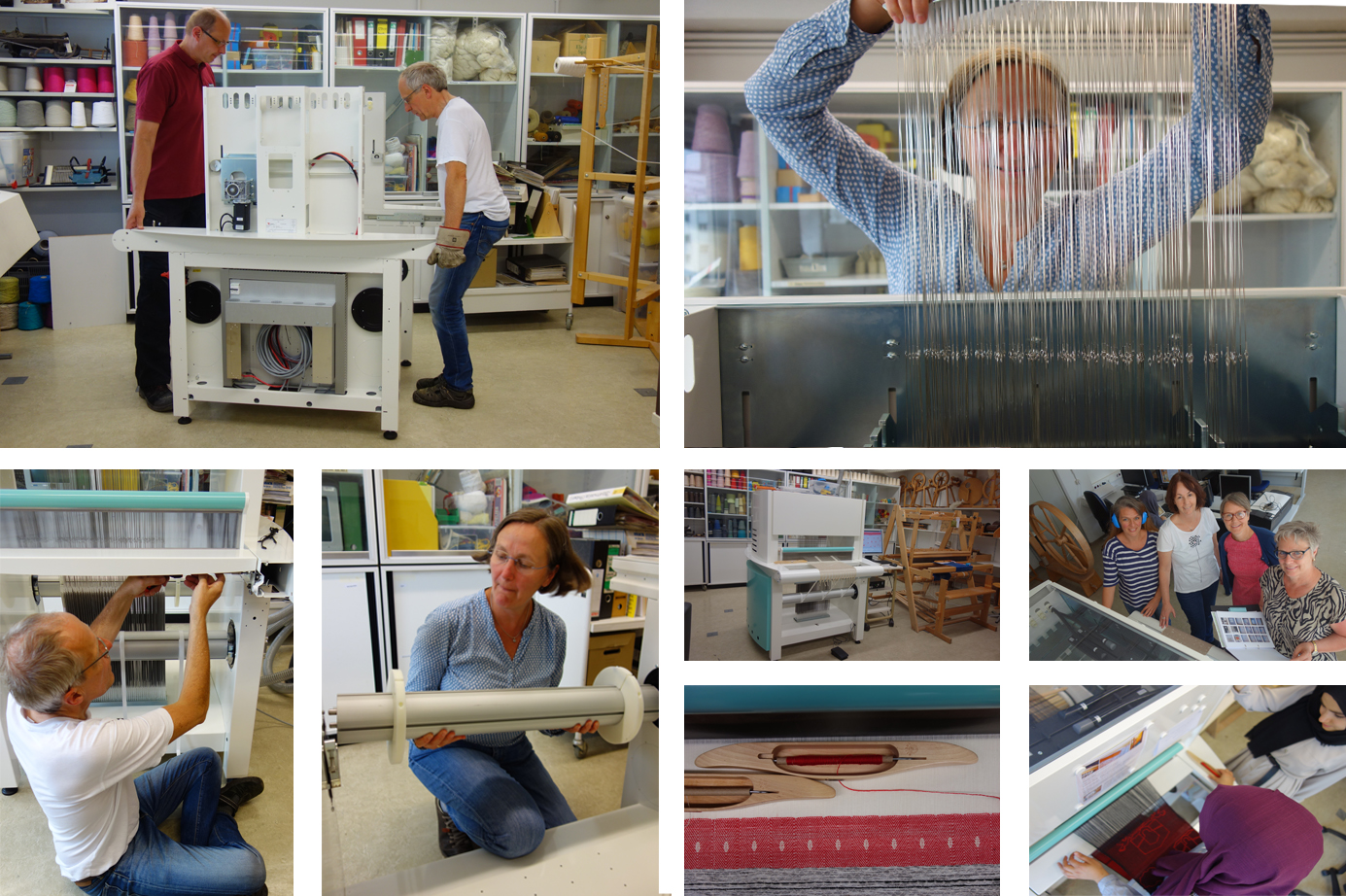
TC2 digital Jacquard loom for teaching
Digitalisierung im restrukturierten Werkstattbereich
Following an extensive restructure of the workshop, Textile Studies now increasingly incorporates digital technologies in its research and teaching activities.
The equipment is being rearranged, weighted and aligned to the future in a balancing act between analogue and digital technology. This involves the commissioning of a digital Jacquard loom, TC2. In the basic concept, this leads to the creation and expansion of a textile research laboratory for students and teachers with future-proof equipment.
A conclusive link is established between the historically evolved technical equipment of a punchcard Jacquard loom with a card punching machine as an analogue prototype of digitization and the latest development of digital weaving technology.
Photos und text: Lucia Schwalenberg
------------
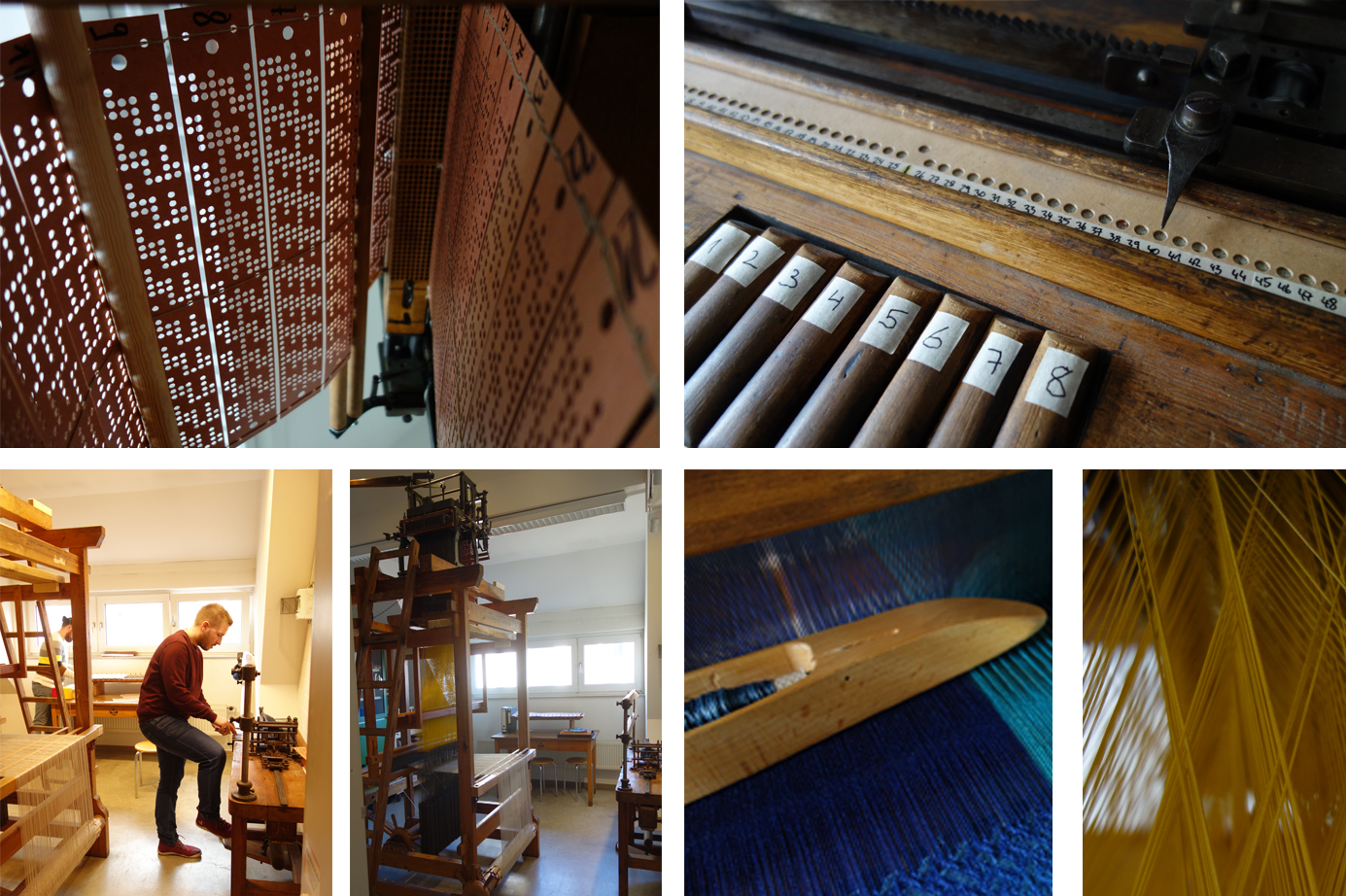
A fully functioning historic punchcard Jacquard loom
Restoration of Textile Studies workshop
In the context of restructuring the Textile Studies workshop, the department’s historic punchcard Jacquard loom was restored. The workshop area contains an extensive range of equipment that has evolved culturally/historically – an outstanding resource for a textile education HEI in Germany.
Besides the punchcard jacquard loom featuring a card punching machine and a teaching model, the workshop includes a keyboard loom, a pattern loom, a countermarch loom and a high warp loom, table looms and a variety of weaving frames and devices such as bobbin winders and warping trees.
A digital hand Jacquard loom will be purchased to develop teaching in the area of digitization. The exemplary result spans archaic textile techniques, industrial production techniques and digital technology in the textile sector.
Photos und text: Lucia Schwalenberg
------------
Clothes make the man – Are we what we wear, or do we wear what we are?”
Professor Dr. Bärbel Schmidt at the Osnabrück Science Forum
33 professors went on stage to give their scientific opinion on questions concerning the future that citizens of Osnabrück had asked. In her talk, Professor Dr. Bärbel Schmidt from the Department of Textile Studies addressed the following question: “Clothes make the man – Are we what we wear, or do we wear what we are?”
Video: talk by Prof. Dr. Bärbel Schmidt
------------
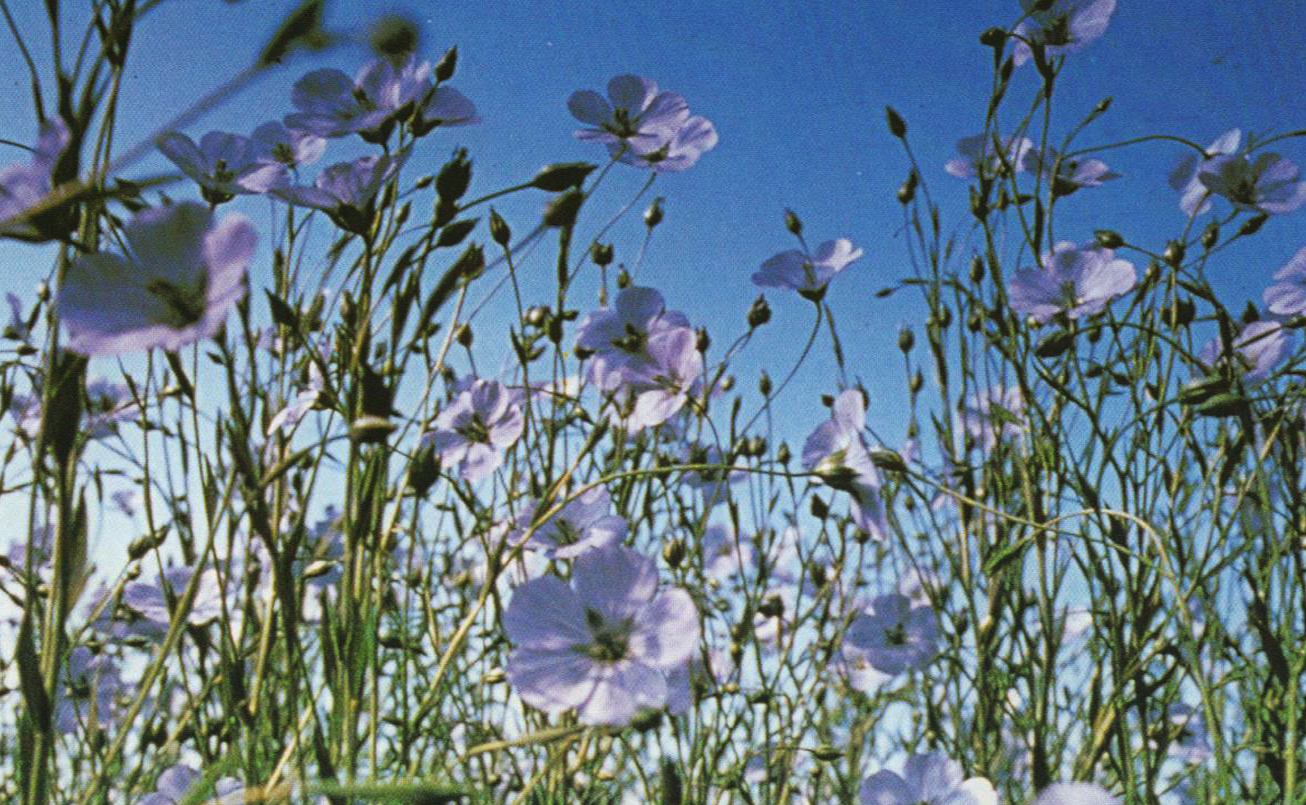
Flax project
Sowing seeds in the museum garden
A flower bed is being prepared in front of the previous entrance to the Osnabrück Cultural History Museum. The intention is to sow flax there, where it can grow and flower, drawing attention to the special exhibition entitled
“Flax 2016 – true born Osnabrughs”, to be showcased in August 2016. In April 2016, Professor Dr. Bärbel Schmidt from the Department of Textile Studies presents the rites formerly used in the Osnabrück region for sowing linseed in the garden of the Cultural History Museum / Felix Nussbaum House. Under the direction of Christiane Harig, children from the CampusKita Day Nursery run by Osnabrück Student Services will accompany the event with spring songs. They will also symbolically sow linseed. According to an old farmer’s saying, it takes 100 days to tell whether the seed will sprout and the flax blossom.
All the same, by the time the exhibition “Flax 2016 – true born Osnabrughs” opens in May, it should be possible to see the first few green shoots. The exhibition does not only focus on the past, when fiber flax was native to the region and Osnabrück’s merchants successfully traded in the durable linen fabric known worldwide as “true born Osnabrughs”. Instead, the exhibition, developed by students from the Department of Textile Studies, also gives a glimpse of a future in which flax, linseed and linen are an ecologically interesting alternative for some production areas.
------------
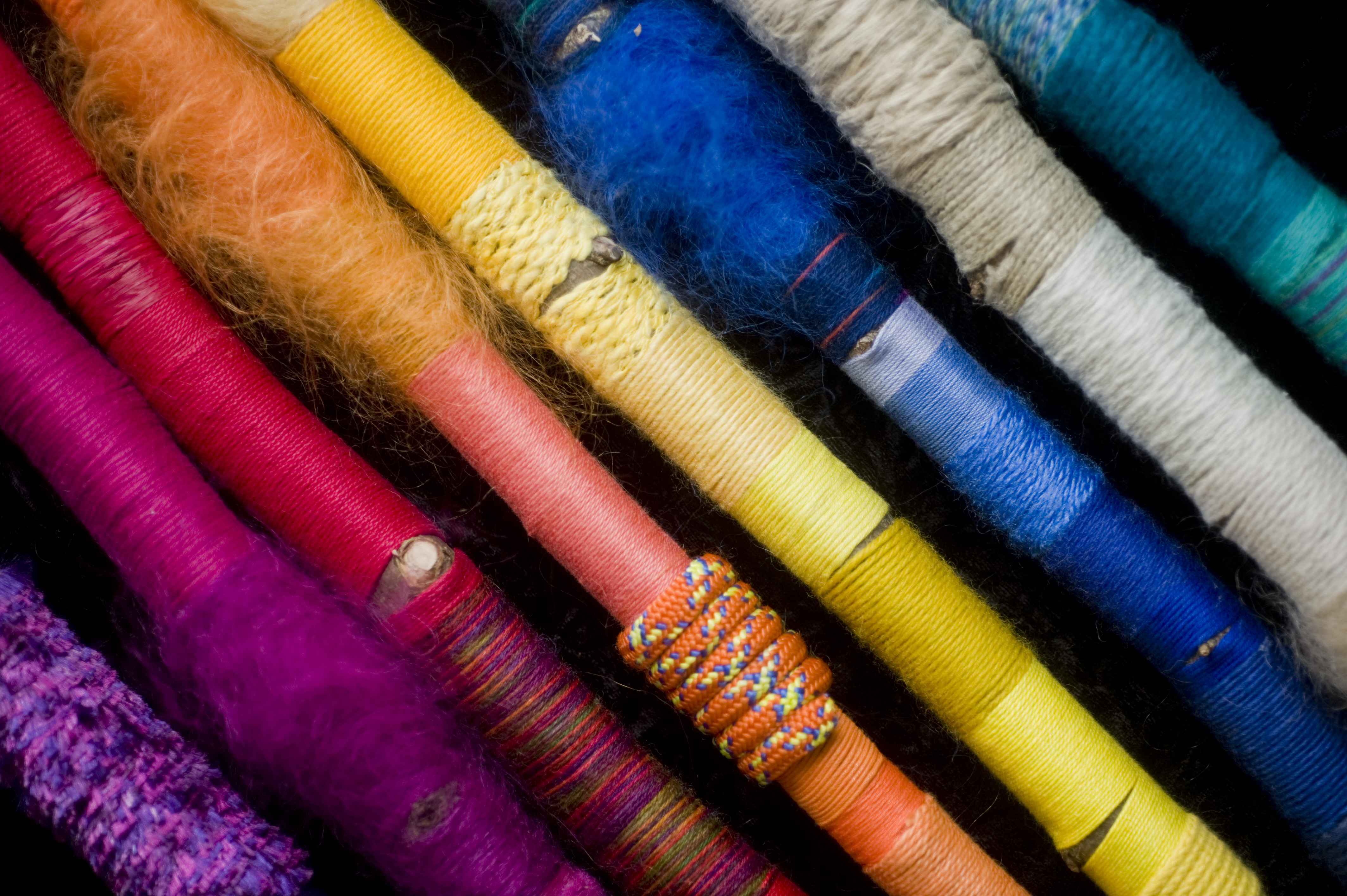
Mixed Textiles
Exhibition in the new library on the Westerberg Campus
The title is the adaptation of a culinary specialty: In 1815, the resourceful town clerk Malthus Hempel advised the town leaders to hide away the streaky bacon and only serve vegetables, due to the turmoil of war caused by Napoleon. His intention was to protect the wealthy city of Leipzig from the anticipated war-induced influx of beggars and tax collectors. On Sundays, the dish could be served with a small piece of Mettwurst sausage or a little crab from the Pleiße. The dish was called: Leipziger Allerlei (Leipzig-style mixed vegetables).
The combination of same-type ingredients shapes the exhibition concept for winter semester 2015. In analogy to colorful food, visitors can expect a variety of textile works, without holding back on the delicacies. The objects were created in recent semesters during seminars led by the lecturers Eva Dankenbring, Annette Hülsenbeck, Hiltrud Schäfer and Professor Dr. Bärbel Schmidt in collaboration with Klaus Schmidt and Jürgen Menkhaus.
Thanks to all the students for sharing their exhibits with us.
------------
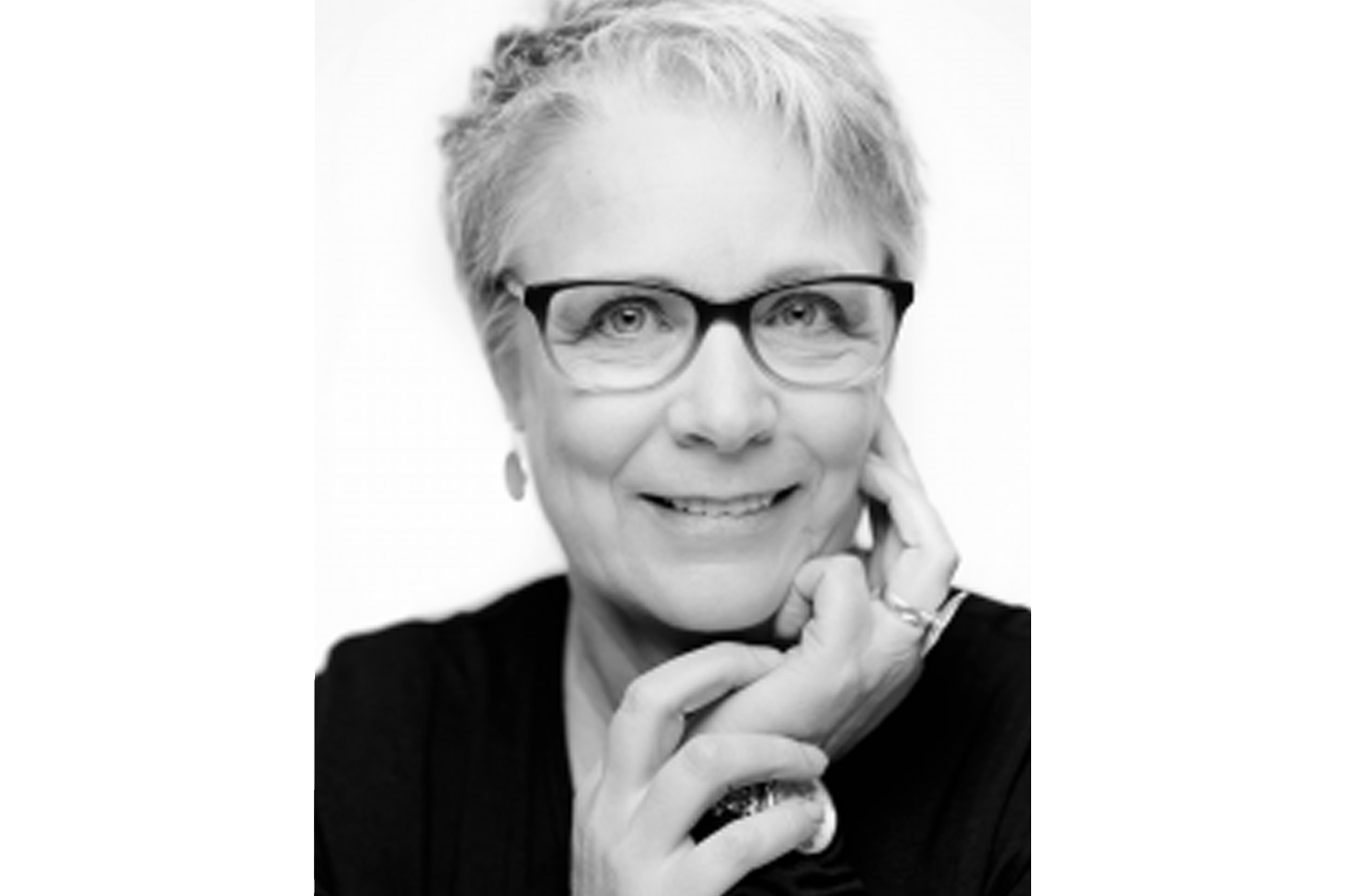
Bärbel Schmidt: Best university professor in 2014
Mühlenhoff Prize for Good Academic Teaching
Professor Bärbel Schmidt has been awarded the Hans Mühlenhoff Prize for her “excellent university teaching.” A nine-member student jury selected Bärbel Schmidt from 18 academics at the university who had been nominated by students. The prize, donated by Osnabrück merchant and patron Hans Mühlenhoff, is endowed with €3000, and has been awarded annually since 2001. More than 400 students submitted proposals for the prize.
According to the jury, Professor Dr. Bärbel Schmidt knows how to make her courses “exciting, eventful, well-structured and informative – all rolled into one.”
Vice President for Academic Program Development and Teaching, Joachim Härtling, paid tribute to Bärbel Schmidt at the award ceremony: “Prize-winner Professor Bärbel Schmidt is a university lecturer with a long track record of excellence in teaching. In particular, her dedication and her creative methods are rightly recognized and appreciated by her students.”
Bärbel Schmidt has been teaching and researching Textile Studies at Osnabrück University since 2006. She addresses issues such as why clothing can stigmatize, and how to use scientific forensics to extract knowledge from textiles.
------------
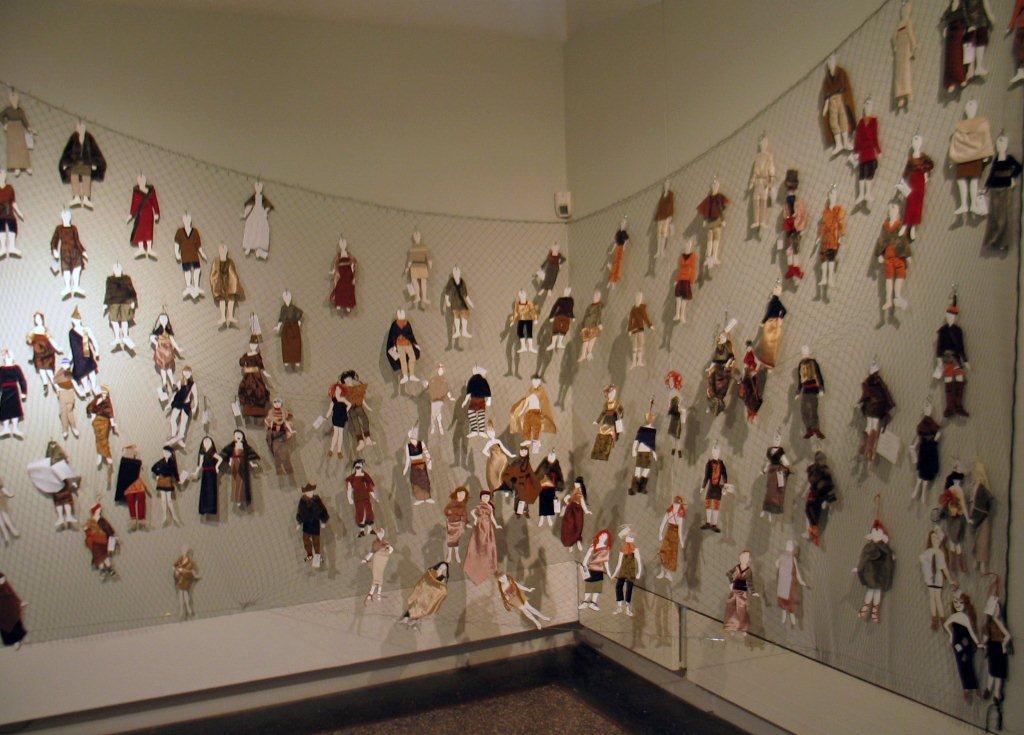
Learning from a box
“Hands-on museum”
When talking about museum reform, it is often mentioned that objects should not be touched. And yet such a ban, which is apparently typical of museums, is understandable. After all, where would the Crown Jewels of the Queen of England and Charlemagne’s crown be now if we were all allowed to touch them? Attempts were made to find new ways of approaching exhibits directly by using replicas or media interventions where visitors can turn the pages of a book using a touchscreen, for example.
Textile Studies students have found another hand-on approach for museums. They provided visitors with materials related to a task concerning the city’s history or citizen participation. For example, they created dress-up dolls that historic costumes could be “stapled” on to. In another section, strips hung from the wheel of Osnabrück’s coat of arms, where citizens could express what they liked about the city. The students also used an old but popular game: visitors had the opportunity to lend their faces to figures dressed in period clothing and have their photo taken. A pyramid of fabrics illustrating the urban hierarchy enabled visitors to touch both the precious and shabby textiles from which clothes were made in the past. The narrowness of the Old Town, with its house names and signs, was highlighted in an installation that proved popular with the audience, which involved them having to make their way through dangling strips of fabric.
The students from the Department of Textile Studies developed such successful contributions for the exhibition marking the 500th anniversary of Osnabrück Town Hall because they want to become teachers. This is why their training includes not only cultural history, but also textile and teaching practice. The students were able to incorporate all three elements into their contributions.
Text: Prof. Dr. Bärbel Schmidt
------------
Speech from the pulpit on the topic of humor
Professor Dr. Bärbel Schmidt in St. Catharine’s Church
On November 11, 2012 at 5.30 p.m., Professor Dr. Bärbel Schmidt gave a speech on humor from the pulpit of St. Catharine’s Church in Osnabrück during an ecumenical university service. After the service, the congregation was invited to round off the evening chatting over bread and wine in the side aisle.
Cooperating organizations: Protestant Students Community, Catholic Students Community, Osnabrück University / Institute of Protestant Theology, Osnabrück University / Institute of Roman Catholic Theology, Osnabrück University of Applied Sciences, University Pastor Ute Schneider-Smietana, University Chaplain Birgit Hosselmann
fileadmin/Audio_Textil/Kanzelrede_Schmidt.MP3
------------
In praise of slowness
Professor Dr. Hilbert Meyer on a teaching methodology
In his novel entitled “Die Entdeckung der Langsamkeit” (The Discovery of Slowness), Sten Nadolny describes a negotiation involving the hero, John Franklin, and a chief of an American Indian tribe living in the far north of the continent. The chief had immediately recognized the captain as the leader of the expedition. When asked how he had come to this conclusion, he replied: “He had the most time.” Slowness, a pace that is not very fashionable even today, stands in the way of many for the young John Franklin. And yet – according to author Sten Nadolny – his great successes as captain and explorer of the Northwest Passage are down to this very virtue.
When the pace is slow, more things are retained in the course of the day than when everything goes so fast. He perceives things more accurately and – since he has the necessary time – is also able to imprint them on his mind. Only in a culture that does not value these virtues do slow people come off badly. This can also happen in school. So it’s worthwhile thinking about it.
Dr. Hilbert Meyer is Professor Emeritus of Education and, alongside Wolfgang Klafki, one of the great conceptual thinkers on educational reform in recent decades. The educator gave his talk on “In praise of slowness” in the auditorium of the palace on June 27, 2012 at the invitation of the Department of Textile Studies and the Center for Teacher Education.
Lecture: In praise of slowness
------------

